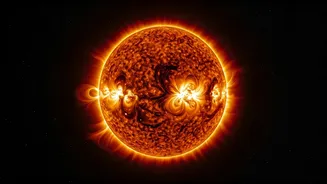Waves' Elusive Nature
The hunt for these specific waves, known as Alfvén waves, has been a quest spanning eight decades. These waves, which are key to understanding how energy
travels through the Sun's atmosphere, have proven difficult to detect due to the intense environment they exist in. The Sun's corona, which is the outermost layer of its atmosphere, is a very hot and turbulent environment, making it hard to observe the waves' movements. Scientists needed exceptionally sensitive instruments and innovative observational techniques to finally unveil these hidden waves, which were concealed within the Sun's energetic environment. Detecting these waves helps scientists to more accurately measure magnetic fields and better understand solar flares and coronal mass ejections.
Decades of Perseverance
The journey to detect these waves highlights the persistence of scientists and their unwavering commitment to unraveling the Sun's mysteries. The search involved continuous refinement of scientific instruments and methods to look at the Sun. Initially, observations were restricted by the limitations of technology. However, advancements in space-based observatories and advanced analysis techniques opened new avenues for detection. The waves' presence was theorized for a long time before they were observed. The culmination of this decades-long quest resulted in a significant breakthrough, offering a new perspective into solar physics and enhancing the tools available for studying the Sun's impact on space weather and Earth.
Solar Flare Insights
The discovery of Alfvén waves holds profound implications for understanding solar flares, which are sudden releases of energy from the Sun's surface. These powerful events emit bursts of radiation that can affect Earth, including disruptions to communication systems and power grids. Understanding how Alfvén waves behave can help us understand the root cause of flares. The waves play a role in transporting energy within the Sun's atmosphere and are believed to be instrumental in the flare process. The research provides more accurate models for predicting the occurrence and intensity of solar flares, leading to improved warnings and preparations for potential space weather events that might disrupt everyday life. With this knowledge, we can also begin to understand the role of magnetic fields during these high-energy eruptions.
Earth's Protective Shield
The Sun's behavior has a significant impact on Earth, as it's the source of space weather, which can affect satellites, communication networks, and the electrical grid. Coronal mass ejections (CMEs), massive expulsions of plasma and magnetic fields, are also key aspects of space weather that have an impact on our planet. Understanding Alfvén waves aids in forecasting these CMEs and assessing their potential impact on Earth. By studying the waves, scientists can understand how energy is transferred within the Sun and predict the onset and power of these events. This will enable better preparedness and mitigation strategies. This discovery provides more accurate models for predicting the occurrence and intensity of space weather events, leading to improved warnings and preparations for potential disruptions.
Future Research Pathways
The discovery of Alfvén waves is only the beginning. The next steps will involve conducting in-depth analyses of wave characteristics, to refine existing models. Future research efforts will focus on exploring the relationship between Alfvén waves and other solar phenomena, such as solar flares and CMEs. Scientists are also looking at how the waves travel through the Sun's complex magnetic field, to better understand energy transport. It is hoped that this will lead to new insights into the Sun's behavior and its relationship to space weather. Advancements in observational technology, along with increased collaborative efforts among scientists from around the world, will be essential for making progress.












